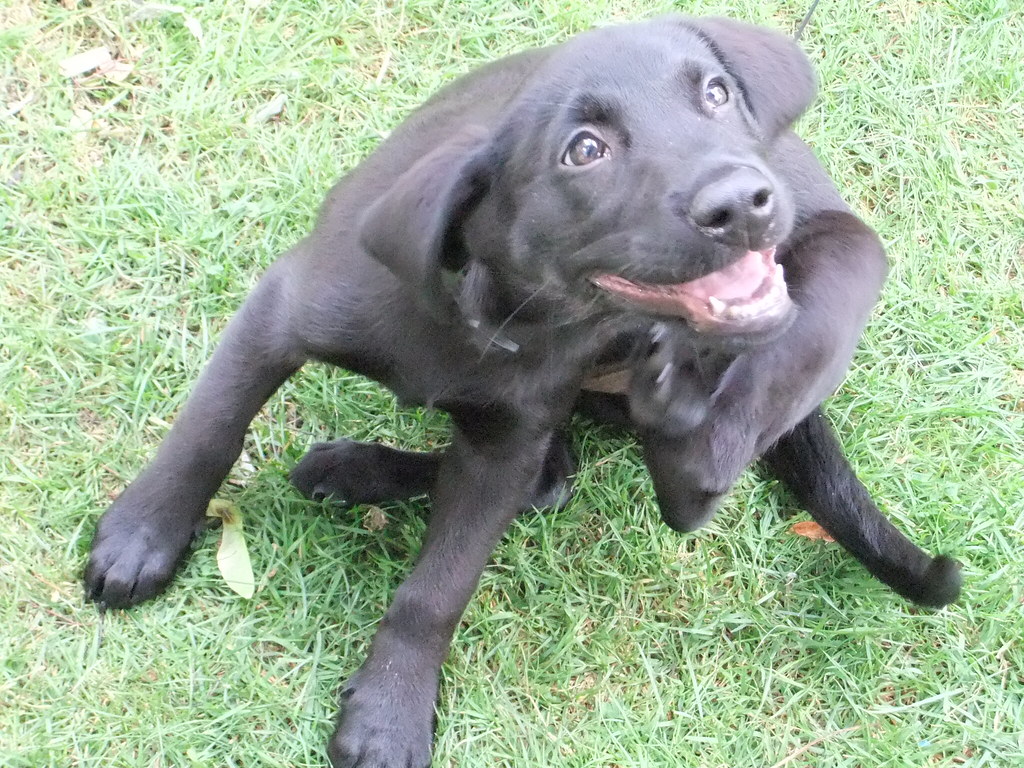Poison ivy on a dog appears as red, itchy, and irritated skin with a rash and blisters. Many pet owners are vigilant about keeping their furry companions safe from harm, but sometimes dogs can come into contact with poison ivy without their humans realizing it.
Poison ivy, scientifically known as Toxicodendron radicans, can cause a range of uncomfortable symptoms for dogs when they come into contact with the plant. Upon exposure, the dog’s skin may develop a red, itchy rash with blistering. In some cases, dogs may even experience swelling and inflammation in the affected areas.
Understanding what poison ivy looks like on a dog is crucial for prompt identification and treatment to alleviate the discomfort and potential complications for our beloved pets.

Credit: www.reddit.com
Signs And Symptoms
Poison ivy on a dog is characterized by red, itchy rashes, swelling, and blisters on the skin. Look out for signs like hair loss and intense scratching. It’s essential to identify these symptoms early for prompt treatment.
Skin Rash
A skin rash is one of the most common signs of poison ivy exposure in dogs. If your furry friend has come into contact with poison ivy, you may notice redness, swelling, and irritation on their skin. The rash can appear as small bumps or blister-like lesions. It often develops within a few hours to a few days after contact with the plant. The area affected by the rash may be warm to the touch and your dog may be tempted to scratch or bite at it. So, keep an eye out for any unusual changes in your dog’s skin, especially if they have been exploring areas where poison ivy grows.
Itching And Irritation
One of the key signs that your dog may have encountered poison ivy is itching and irritation. Dogs may experience intense itching, which can lead to excessive scratching or biting. If you notice your dog constantly licking or chewing a particular area, it could be a result of poison ivy exposure. Itching is a typical reaction to poison ivy’s toxic oil called urushiol, which causes an allergic reaction in dogs, just like it does in humans. The more contact your dog has had with poison ivy, the more severe the itching and irritation may be.
Additional symptoms to watch out for are redness and swelling. These are often accompanied by discomfort and pain. If your dog is exhibiting signs of itching, irritation, redness, or swelling, it’s important to take action and seek veterinary advice. Your vet can provide the appropriate treatment to alleviate your dog’s symptoms and prevent any potential complications.

Credit: www.farmanddairy.com
Visual Appearance
Identifying poison ivy on your dog can be crucial in preventing further discomfort and giving them the necessary care. Understanding how poison ivy presents itself visually on a dog can help you take appropriate action promptly.
Redness And Swelling
One notable visual sign of poison ivy on a dog is the presence of redness and swelling. The affected area may appear inflamed and there could be visible swelling. If you notice any abnormal redness or swelling on your dog’s skin, it’s important to investigate further.
Blister Formation
Another visual indicator of poison ivy on a dog is the formation of blisters. These blisters may be small or large and can contain fluid. Keep an eye out for any blister formation on your dog’s skin, particularly in areas where they may have come into contact with plants.
Ulceration
Ulceration may also occur as a result of poison ivy exposure in a dog. This can manifest as open, slow-healing wounds on the skin. If you observe any signs of ulceration, it’s essential to seek veterinary care promptly.
Identifying Characteristics
Poison ivy can cause a range of uncomfortable symptoms in dogs, making it important for pet owners to be able to identify the plant. Recognizing the identifying characteristics of poison ivy can help you keep your furry friend safe and prevent exposure. Here are the key characteristics to look out for:
Three Leaflets
Poison ivy typically has three leaflets, each with its stem, attached to a single main stem. This distinctive feature is important to remember when identifying the plant, as it differs from many harmless plants with differing leaf patterns.
Toothed Margins
The edges of poison ivy leaves often have a distinct jagged or tooth-like appearance. This toothed margin is a crucial identifying characteristic and can help distinguish poison ivy from similar-looking plants.
Shiny Surface
Poison ivy leaves have a shiny surface, which can aid in their identification. This glossy appearance can be a useful indicator, especially when combined with the plant’s other characteristic features.
Common Affected Areas
When it comes to the noxious plant poison ivy, dogs are just as susceptible to its irritating effects as humans are. If you suspect your furry friend has crossed paths with this troublesome plant, it’s important to know what to look for. Poison ivy can cause a variety of uncomfortable symptoms in dogs, including itching, redness, swelling, and even blisters. Identifying the commonly affected areas is key to spotting and treating poison ivy dermatitis in your canine companion.
Belly/groin
A dog’s belly and groin area are often the first spots to come into contact with poison ivy. These areas are typically more vulnerable due to their proximity to the ground when dogs explore outdoor environments. Poison ivy leaves, stems, and roots can release a resin called urushiol, which is responsible for the allergic reaction. When a dog’s belly or groin brushes against these parts of the plant, the urushiol can easily adhere to their fur and skin.
- Redness and inflammation
- Itching and scratching
- Possible swelling
- Blisters
Paws
Dogs love to run, dig, and explore with their paws, making them another common area of exposure to poison ivy. When dogs walk on or step into areas where poison ivy is present, their paws can pick up urushiol residue. This can lead to intense itching and discomfort for our four-legged friends.
- Excessive licking and chewing of paws
- Redness and swelling
- Bumps or hives on the paw pads
- Irritated or cracked skin
Muzzle/face
The muzzle and face of a dog are also vulnerable to coming into contact with poison ivy, especially if they have been sniffing or exploring areas where the plant is growing. Urushiol can easily transfer from the dog’s fur to their face, causing discomfort and visible symptoms.
- Itchy nose and muzzle
- Redness and swelling around the eyes
- Bumps or blisters on the face
- Possible difficulty eating or drinking
If you suspect your dog has encountered poison ivy and is displaying any of these symptoms in the commonly affected areas, it’s important to seek veterinary care. A professional can provide appropriate treatment to help alleviate your dog’s discomfort and prevent any further complications.
Prevention And Treatment
When it comes to poison ivy on dogs, prevention and treatment are key to keeping your furry friend safe and comfortable. By taking the necessary precautions, you can help your dog avoid contact with poison ivy and minimize the risk of developing an allergic reaction.
Avoiding Contact
If you want to protect your dog from poison ivy, it’s crucial to know what it looks like. Poison ivy typically has three shiny leaflets with pointed tips. The leaves can be green in the summer and turn red or orange in the fall. To avoid contact with this irritating plant:
- Avoid walking your dog in areas known to have poison ivy, such as wooded areas or overgrown trails.
- Keep your dog on a leash to prevent them from exploring areas where poison ivy may be present.
- Be cautious when hiking or camping with your dog and make sure to stay on marked paths.
- Learn to identify poison ivy by its distinctive characteristics, and teach your dog to avoid it as well.
- Consider creating a barrier in your yard to prevent your dog from coming into contact with poison ivy plants.
Cleaning And Soothing
If you suspect that your dog has come into contact with poison ivy, it’s important to act quickly to prevent the spread of the irritating oils. Here are some steps you can take to clean and soothe your dog:
- Wear protective gloves to avoid getting the oil on yourself.
- Thoroughly rinse your dog with lukewarm water, focusing on the areas that may have come into contact with poison ivy.
- Gently wash your dog with a mild soap or pet shampoo to help remove any remaining oils.
- Pat your dog dry with a clean towel, being careful not to irritate the affected areas.
- Apply a soothing topical ointment or spray recommended by your veterinarian to help relieve itching and inflammation.
Consulting A Veterinarian
If your dog shows signs of an allergic reaction to poison ivy, such as excessive itching, redness, swelling, or oozing sores, it’s crucial to seek professional advice from a veterinarian. They can provide a proper diagnosis and recommend suitable treatment options, which may include:
- Prescription medication to alleviate discomfort and reduce inflammation.
- Antihistamines to help control itching and allergic reactions.
- Topical creams or ointments are specifically formulated to soothe irritated skin.
By promptly addressing any potential poison ivy exposure, properly cleaning and soothing your dog, and seeking veterinary guidance when necessary, you can help ensure your canine companion stays safe and comfortable, free from the bothersome effects of poison ivy.

Credit: mcleanah.com
FAQ On What Does Poison Ivy Look Like On A Dog
What Are The Symptoms Of Poison Ivy On A Dog?
Poison ivy on a dog can cause itching, redness, swelling, and blisters. Your dog may also experience hair loss and skin irritation in the affected area. If you notice these symptoms, it’s important to seek veterinary care to provide relief for your furry friend.
Can Dogs Get A Rash From Poison Ivy?
Yes, dogs can get a rash from poison ivy. The allergic reaction occurs when your dog comes into contact with the oils from the poison ivy plant. It’s important to wash your dog with soap and water if you suspect exposure to the plant and seek veterinary care if a rash develops.
How Do You Treat Poison Ivy On A Dog?
If your dog has come into contact with poison ivy, wash them thoroughly with soap and water to remove the oils from the plant. You can also apply a soothing oatmeal bath or calamine lotion to help alleviate any itching or discomfort.
It’s best to consult your vet for further treatment options.
Conclusion
Identifying poison ivy on a dog is crucial for their well-being. By being aware of the telltale signs, such as redness, itching, and blistering, pet owners can quickly intervene and seek appropriate treatment. Preventing exposure to poison ivy is also critical, ensuring a safe and comfortable environment for our furry friends.
Stay vigilant, keep an eye out for these symptoms, and consult a veterinarian if you suspect your dog has come into contact with poison ivy. Your dog’s health and happiness depend on it.



